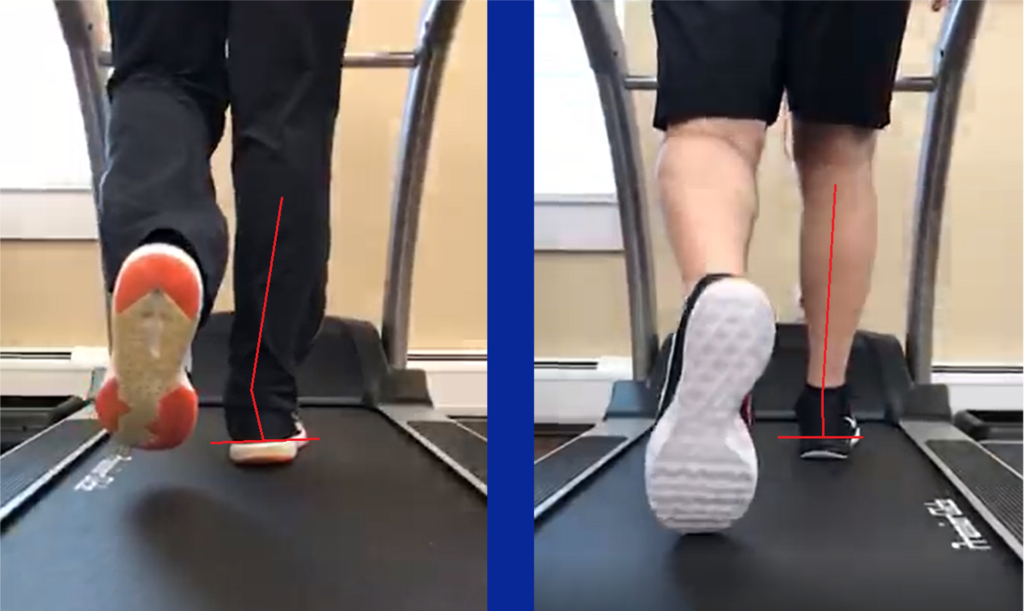Running Analysis and Selecting Proper Running Shoes
Selecting running shoes can be a daunting task – do I get the sneaker with a ton of foam in the heel, the really pretty purple ones, or the bargain rack sneakers for $29.99? Most runners as some point during their running career will go through dozens of sneakers, have running analysis performed, or possibly even hire a running coach.
Running analysis can quickly identify defects in sneakers and biomechanical imbalances, which can lead physical therapists to develop a strength/stretching program and more importantly make recommendations for the proper running sneaker to purchase. Thankfully, there are a few easy tips to consider when selecting running sneakers that can help novice and even experienced runners ensure they have the correct running sneakers.
Running Analysis and How It Helps with Selecting Running Shoes

Running analysis should be part of every runner’s toolkit to ensure they have the right sneakers and especially correct form to limit injuries and improper running form.
When we evaluate a runner’s sneakers and form on a treadmill, we have them bring in their current sneakers for the initial evaluation. The patient walks, then runs while we record their form, then we review the video where we demonstrate the biomechanics of all pahses of gait including: heel strike (when the heel hits the ground), mid-stance (when the hip/knee/ankle are aligned with one another) and pushoff (when the toes are flexed and about to leave the ground).
Watching how the heel hits the ground and how much the ankle rolls in or out can dictate how the knee and hip are affected during each phase of gait. Too much roll inwards (pronation) can lead to ‘Runner’s Knee or ITB Syndrome‘ where the knees roll inwards, and too little roll (supination) can lead to increased shock and strain to the legs causing foot pain/ankle sprains and hip dysfunctions.
When performing running analysis and filming in slow-motion, the angle of foot strike, amount of ankle roll, and knee angle can easily be measured allowing the physical therapist to make proper recommendations for the correct running sneaker.
The easiest way to think about your foot is if your your ankle rolls inward, you are a pronator (low arch). When your heel strikes and your ankle rolls outwards onto the outside of your foot, you are a supinator (high arch). If your foot rolls inwards slightly at heel strike, you are neutral, right in the middle. With a low arch/pronator, you want a more rigid sneaker; with a high arch/supinator, you want a sneaker with more cushioning. With a neutral foot posture, you want a sneaker with some cushioning and some stability.
The easiest way to analyze a sneaker is to twist the sneaker by holding the heel and the front part of the sneaker. If the sneaker bends and twists easily, this sneaker would be appropriate for a supinator. If the sneaker hardly bends, this rigid sneaker should be worn by a pronator. If the sneaker twists a little bit, then you have a neutral sneaker.
When we analyze someone running, we prefer to analyze someone’s running mechanics during different times of the day, and also when they are ‘fresh/rested’ and when they are ‘tired/fatigued’. Many times you will not see proper biomechanics until after a few miles, where one’s form can start to break down from muscle fatigue and weakness. The proper sneaker at Mile 1 might be vastly different from Mile 6. We usually have a patient come straight in from a run of 2-4 miles so we can analyze them when they are ‘fatigued’.
Running analysis can make a significant difference in helping patients and runners of all ability and skill levels ensure they are running and competing in the correct sneakers. Usually by prescribing some simple exercises and recomending sneakers based upon the patient’s foot and ankle posture we can help alleviate common runner problems and limit further injury from occurring.
Have you ever had any running injuries or have been unsure about what sneaker is right for you? With running analysis we can help find the right fit for you.

